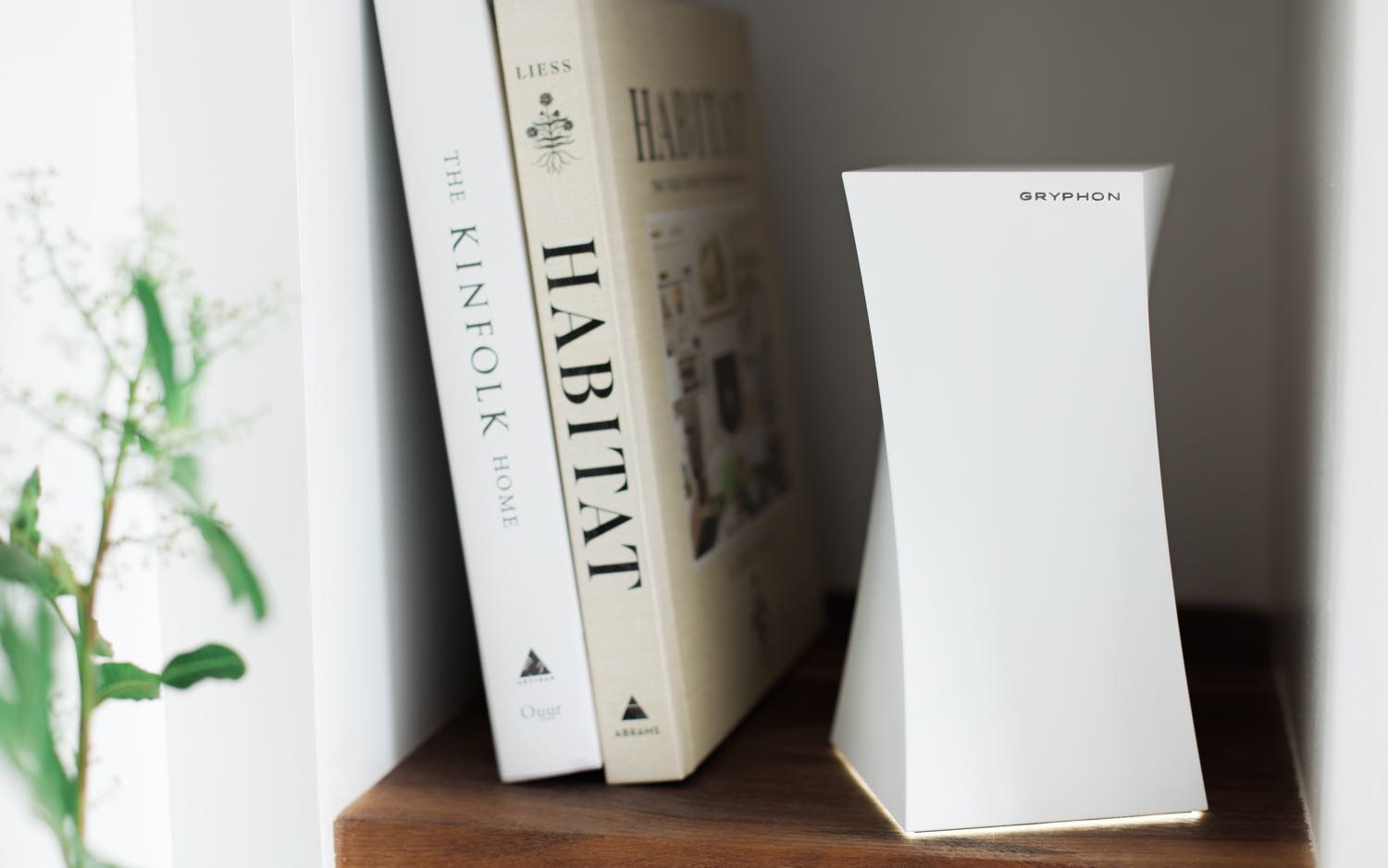Tom's Guide Verdict
Big and twisted, the Gryphon Secure Mesh System looks like no other router on the planet. It provides excellent throughput and a phalanx of security measures to protect a family's data and digital identity.
Pros
- +
Excellent performance
- +
Includes security software
- +
Triband design with dedicated backhaul channel
Cons
- -
Lacks USB port
- -
Large
- -
Expensive
Why you can trust Tom's Guide
The Gryphon Secure Mesh System enviably combines outstanding speed, security and parental controls to protect a family's digital goods with a unique look that would be a shame to hide in the basement. Its tri-band design has a dedicated backhaul channel and the router automatically optimizes its data flow, but Gryphon is among the most expensive ways to fill a home with Wi-Fi and does it without the convenience of a USB port.
Expense aside, it still finds a place on our list of the best mesh Wi-Fi systems you can buy, thanks to great performance and a focus on safe, secure browsing for the whole family.
Editor's Note (1/21/2020): Gryphon has reached out to us with some new spec information, and we've updated our review accordingly. The original rating remains unchanged, and the Gryphon Secure Mesh System remains one of our favorite security-focused routers.
Design
Easily one of the most interesting-looking networking devices, the Gryphon Secure Mesh System's large white rectangular tower has a quarter-turn vertical twist to them. At 4.5 x 4.5 x 9.5 inches, each Gryphon Secure Mesh System (SMS) device is big and chunky, but 30 percent smaller than Netgear’s Orbi Voice RBS40V speaker extension; Gryphon lacks the audio abilities of the Orbi Voice extension.
The Gryphon device is so unique looking that it can be shown off in a living room, kitchen or den. On the downside, the Gryphon device can't be wall mounted.
The $430 Mesh Double Pack includes a pair of identical white devices, power adapters and a Cat-6 networking jumper cable. An individual Gryphon device, which can be used as a router or as an extension, costs $230. A Gryphon-based network can have as many as six extensions, rather than the unlimited number of extensions that Samsung's SmartThings supports.
Each Gryphon tower has LEDs on the underside of the unit that blinks white when it’s ready to be setup and solid white when everything’s done. Unfortunately, they continue to be white as if nothing is wrong even during an Internet outage, but the app shows the disruption.
Get instant access to breaking news, the hottest reviews, great deals and helpful tips.
Unlike Orbi, the devices are identical and during the setup procedure you decide which will be the base router and the extension. Under its twisted skin is a triband 802.11AC router that can move up to 400Mbps over a single 2.4GHz channel, as well as 1.7Gbps over its primary 5GHz channel and 866MHz over its secondary 5GHz channel. Like the Orbi Voice RBK50V, Gryphon has a dedicated 5GHz backhaul channel and the device tops out at about 3Gbps.
- More: A router VPN can secure every device you own
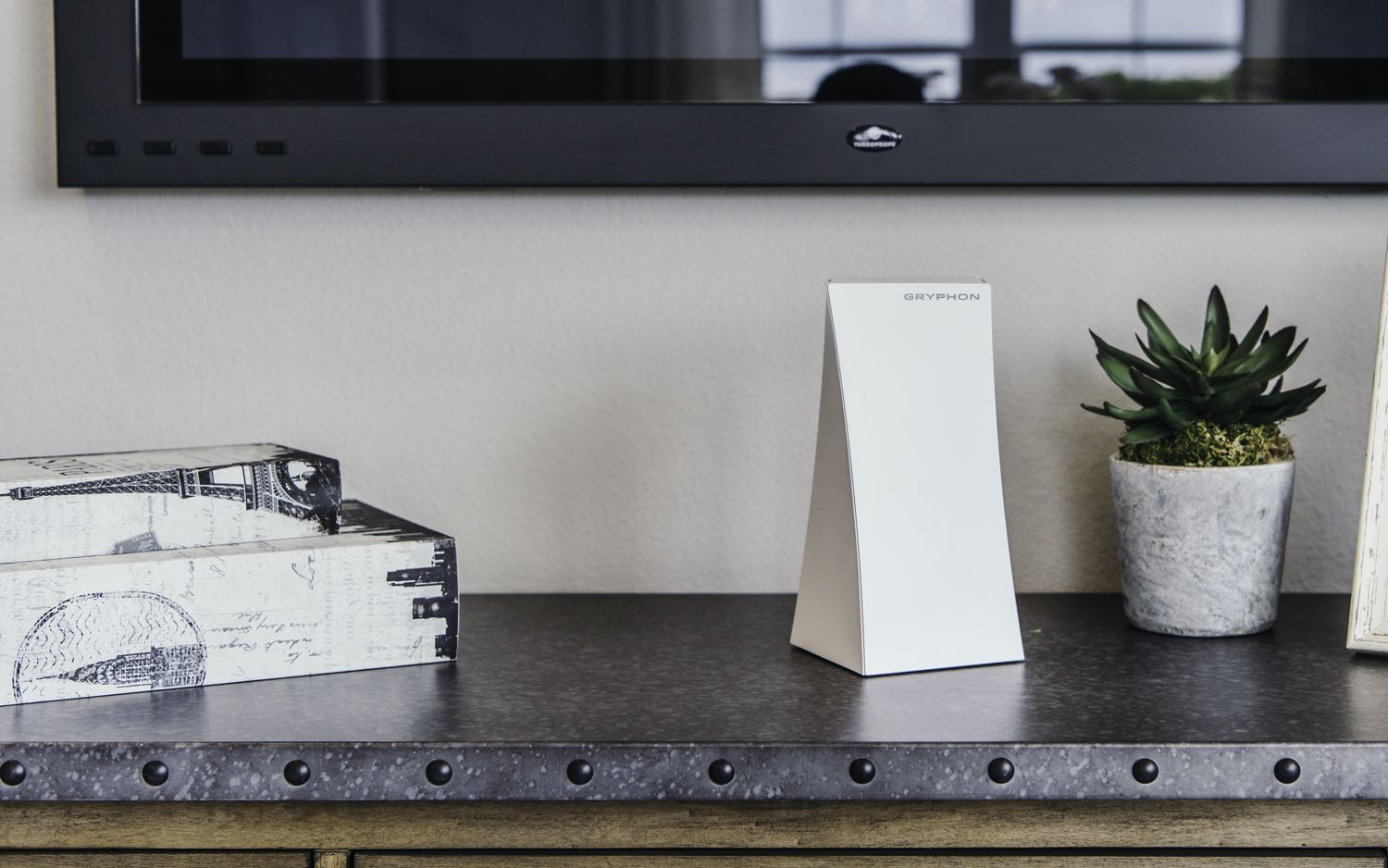
Inside, the Gryphon SMS device has six antennas that are positioned at right angles to each other. Their signals are boosted by an internal power amplifier to catch weak signals.
Underneath each Gryphon device is an Ethernet port for your broadband modem as well as three downstream networking ports; all can move gigabit per second data. There's a power connection and a recessed reset button, but Gryphon lacks a USB port for adding USB-connected devices, though Ethernet will still work for most networked printers or data drives. Happily, the back is open to route the cables through.
Like TP-Link's Archer C5400X and Norton's Core, the Gryphon SMS can add peace of mind with built-in security. It starts with a smart boot arrangement that, like Google WiFi, won't start up if the firmware has been altered. The system adds powerful intrusion detection and parental controls as well as ESET’'s deep database of dangerous software to avoid.
MORE: Don't Rent Your Router: Here Are the Best to Buy
It's just the start because the company plans to add Virtual Private Networking (VPN) in 2019. After a year of included service, it costs $9.99 a month or $99 a year.
Performance
Based on Qualcomm's IQP4019 Wi-Fi chip, 512MB of RAM and 4GB of flash chips, Gryphon is rated at AC3000. It sets up a 4X4 streams and includes MU-MIMO for connecting several clients at once, beamforming to tailor the transmissions to the receiving system and Qualcomm's Wi-Fi SON (Self-Organizing Network) system for sending the data on the most efficient route.
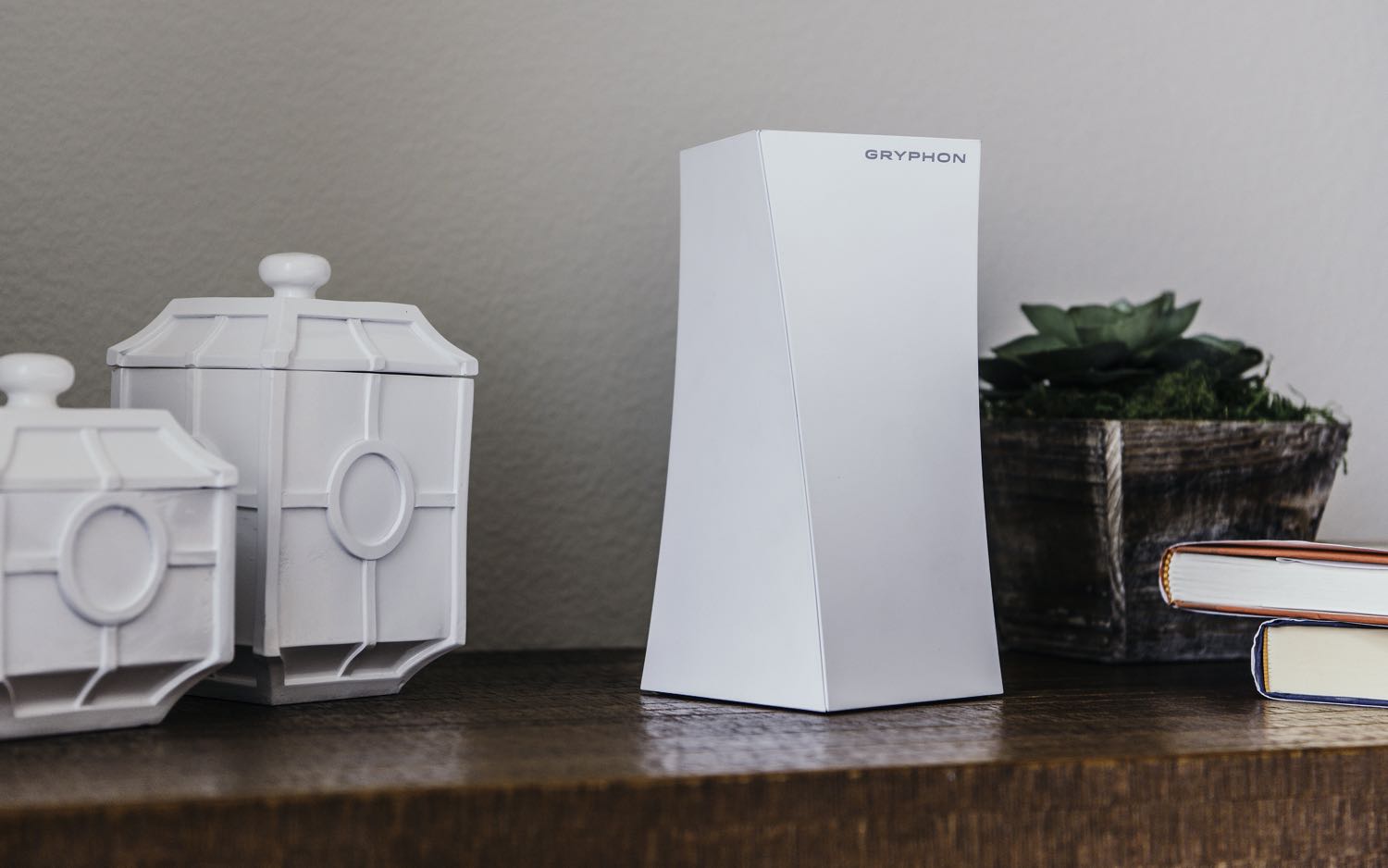
According to the company, a single Gryphon router can fill a 3,000-square-foot home with Wi-Fi. A pair of Gryphons should be enough for a 6,000-square-foot mansion.
Using Ixia's IxChariot network benchmarking software, Gryphon SMS performed exceptionally well, both close-up and at a distance. The system peaked at 682.8Mbps of throughput 5 feet from the router, 11 percent higher than the Orbi Voice RBK50V.
The device continued to excel with 587.5Mbps available at 15 feet and 607.1Mbps at 50 feet, outpacing the Orbi Voice (563.9Mbps and 543.6Mbps) and the Linksys Velop (527.1Mbps and 459.4Mbps) at the same distances. It fell short with 432.5Mbps of throughput at 100 feet, 15 percent off the Orbi Voice's 498.9Mbps, but at 150 feet, Gryphon delivered 387.4Mbps, just ahead of the Orbi Voice (359.9Mbps).

It tore through our penetration tests that mimic home construction materials with a strong 768.3Mbps available on the other side of a soundboard wall, 39 percent and 44 percent higher throughput than the Eero's 471.2Mbps or Orbi Voice's 430.5Mbps. The Gryphon moved 573.4Mbps through a metal wall, slightly ahead of the Linksys Velop's 560.0Mbps and pushed 622.3Mbps up a floor, blowing away the Eero (471.2Mbps) and the Orbi Voice (376.5Mbps).
It was almost enough to fill my 3,500-square foot home, with the router-extension pair leaving a couple of dead zones. Its 90-foot range was 17 percent off Orbi Voice's 105-foot range but should be more than enough for most homes.
MORE: Top-Rated Wi-Fi Extenders to Boost Your Signal
The Gryphon LAN passed our informal saturation test where I listened to internet radio on a MacBook Air while playing HD and 4K videos on a Surface Pro 3 and iPad Pro tablets and I moved data around with a Samsung Tab Pro S. It ran without a problem for a week and used 6.3 watts of power. If you pay the national average of 13 cents per kilowatt-hour for electricity, a pair of Gryphon SMS devices will cost about $15 a year to operate.
Setup
For good or bad, the only way to set up the Gryphon SMS is through its Gryphon Connect app. There are versions for iOS (iPhone or iPad) and Android (phone or tablet). There's no way to use a connected browser. The process works with stand-alone broadband modems and ones that have Wi-Fi routers built in.

After setting up an account, I plugged in the Gryphon router (it doesn't matter which one) into the included power adapter and my broadband modem. Then, I made sure my iPad Pro's Bluetooth radio was turned on and it was close to the Gryphon device.
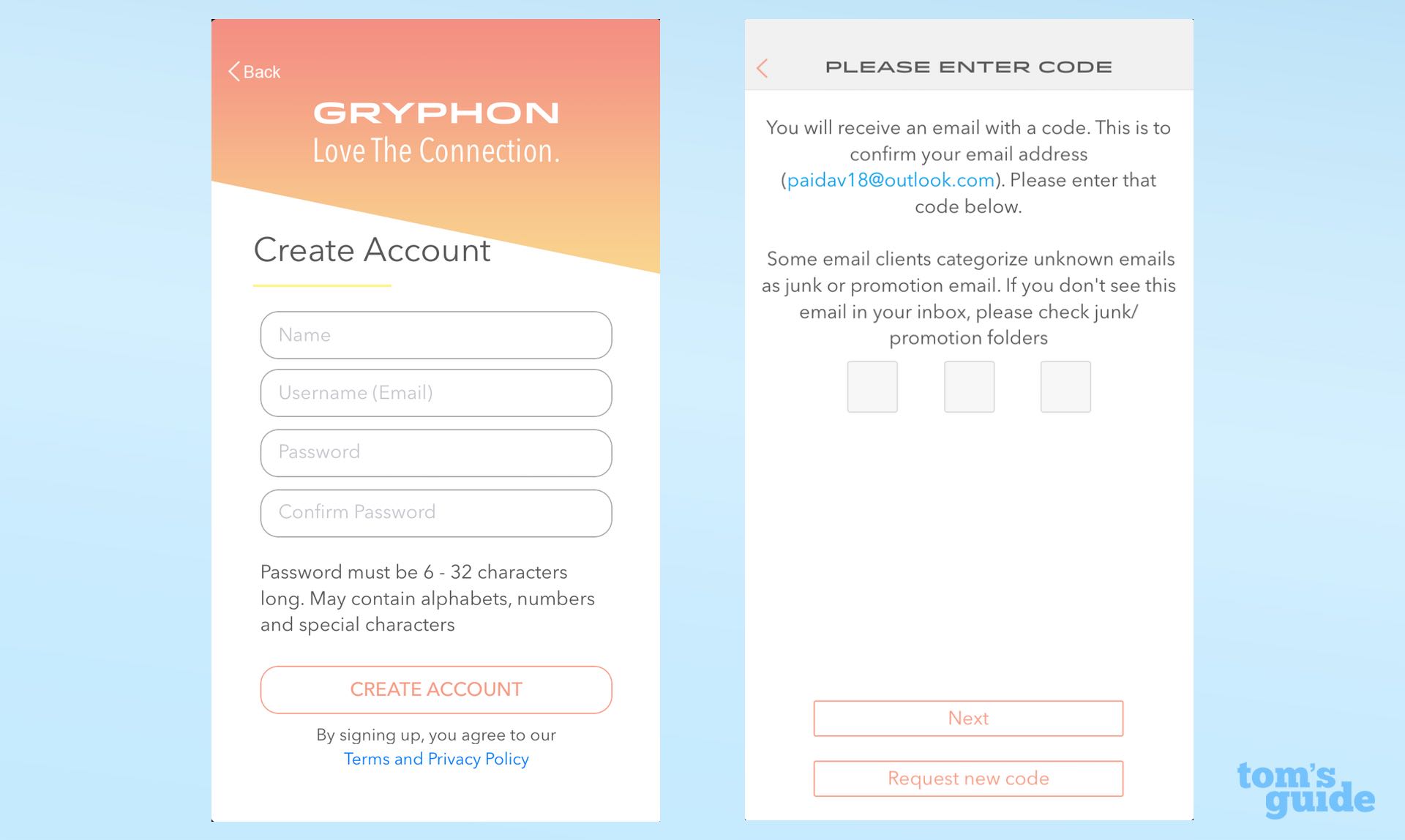
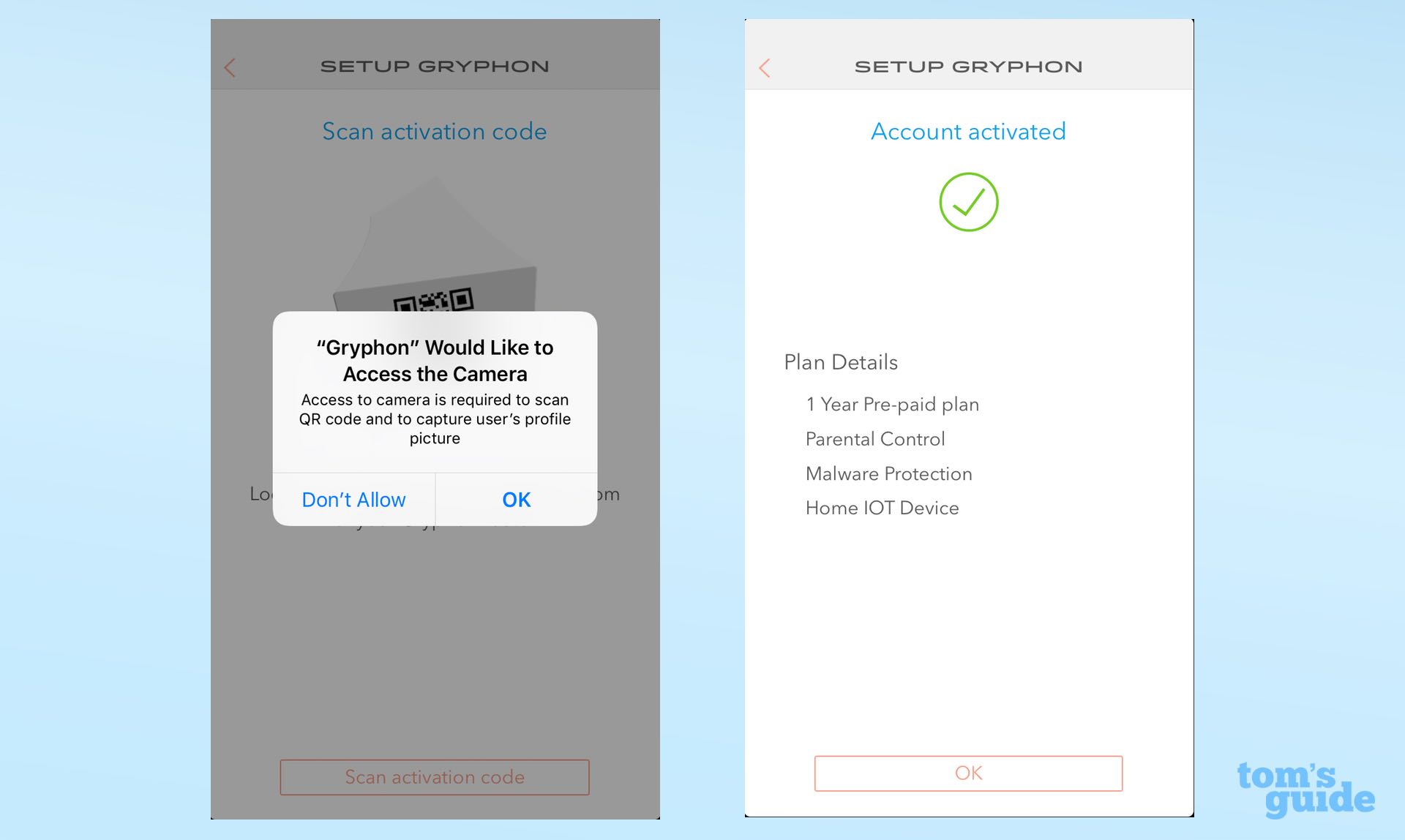
Next, I scanned the QR code underneath the device with the app and tapped the Connect button to pair the router with my tablet. After clicking on a verification email that Gryphon sent me, I changed the router's network name and password to something more secure and personal. A quick reboot and the router's ready.
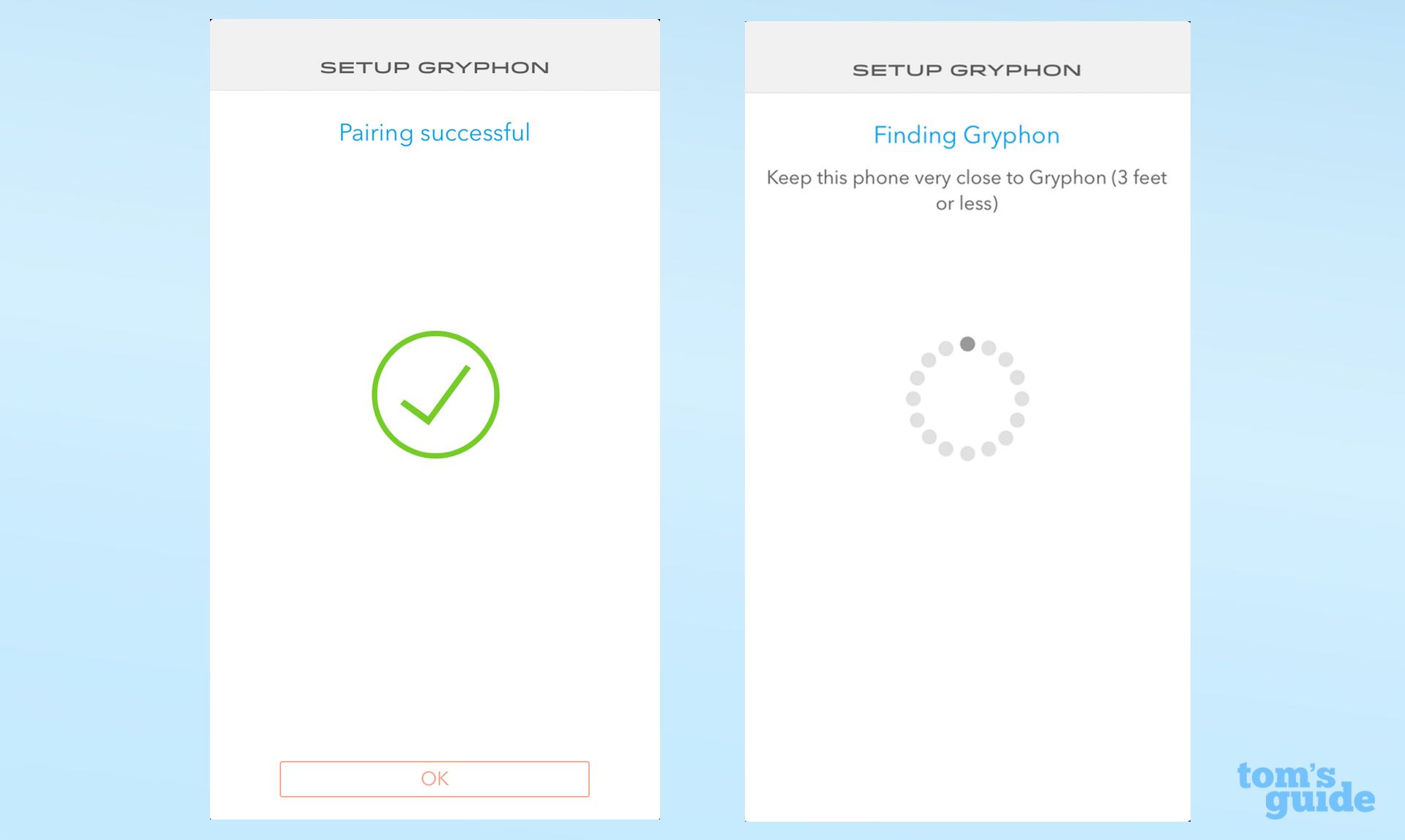
With the other Gryphon device about 35 feet away from the base router, I plugged it in and tapped Add Repeater in the app's Settings. I scanned the QR code underneath Gryphon and the software quickly found the extension. About 3 minutes later, the extension's LEDs went from blinking white light to solid white and a green check mark showed up on the app's screen.

It worked on the first try and pushed the network into new areas of my home. Setting up the Gryphon took 12 minutes, from start to finish.
Configuration
Gryphon's app does it all with configuration, malware protection and parental controls. Routers like TP-Link’s Archer C5400X awkardly split it into two apps. The Gryphon Dashboard shows whether the Internet is connected, how many devices are online and has a Pause button upfront to instantly turn off the Internet for dinnertime or a family powwow.

To get the most of Gryphon, devices should be categorized based on type and use. For instance, "Managed" are computers that can use parental controls, while "Unmanaged" devices are unrestricted and "Things" are home automation and IoT clients. Finally, "TV & Entertainment" are media servers, smart televisions, internet radios and others.
You can run an internet speed test at any time and the latest firmware allows the use of Ethernet cabling to connect the router and the extension. Devices can be set up with static IP addresses and port forwarding. Using its prioritization protocol, I set my system as the top priority for data and then turned off Gryphon's LEDs at night.

The router's parental controls are built around user profiles that can be created by filling in a name, age group and a photo. Underneath are places to control the web filter, SafeSearch, store browsing history and set an internet-free bedtime. Concerned parents can restrict access to several apps during a designated homework time, including Facebook, Hulu and games, like Minecraft. A parent can see what websites a child is visiting and allow access to denied online resources.
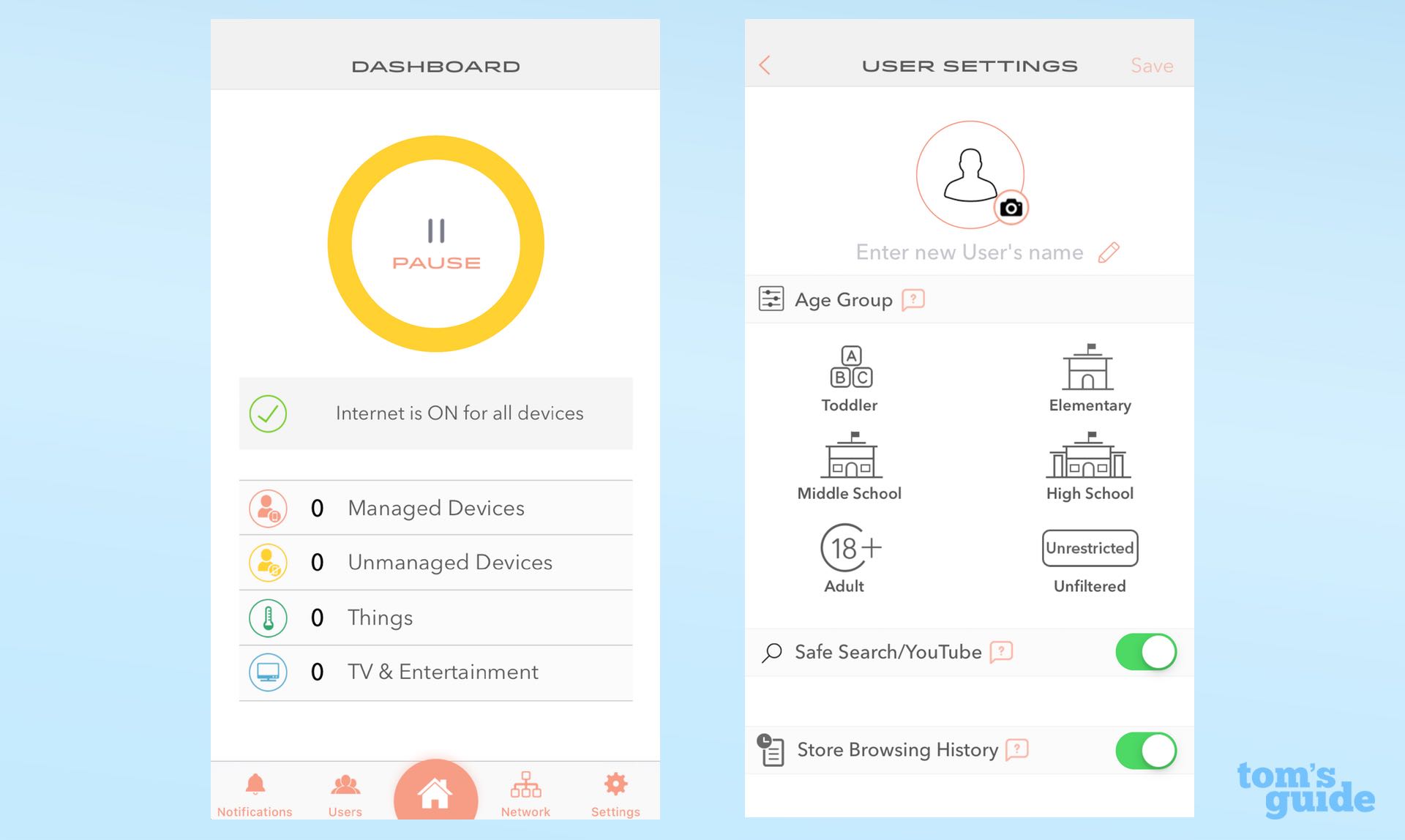
Like Norton Core and TP-Link's Archer C5400X, the Gryphon gear has built-in security software that's meant to augment each device's antivirus software. Based on ESET's extensive database of threats, the router can block known dangerous sites and intrusions, while new threats are evaluated and blocked using cloud-based artificial intelligence.

One thing Gryphon SMS can't do is use Wi-Fi Protected Setup (WPS) to quickly connect to client computers or printers. The company feels the procedure is too insecure for this day and age.

The Gryphon device is backed for a year, which is equal to most warranties but goes beyond Netgear's 90-day support policy. The site has lots of set-up and configuration advice in easy-to-use sections, as well as short videos on the app and support site. Gryphon lacks anything like a comprehensive manual, although the app has a link for directly contacting support technicians.
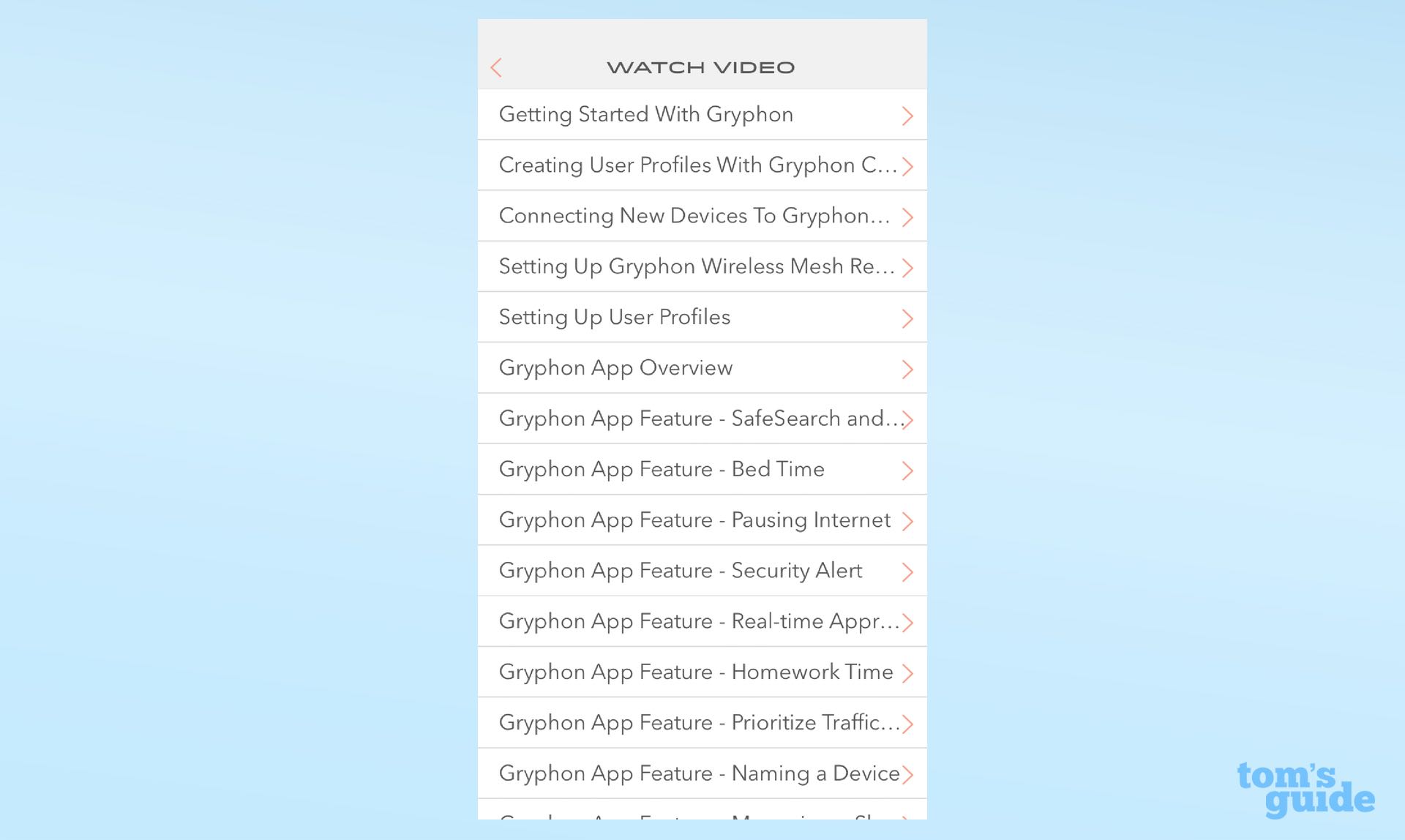
Gryphon Secure Mesh Router Specs
| Wi-Fi Spec | AC3000 802.11ac mesh kit |
| Number of Antennas/Removable | 6/No |
| Ports | 1 WAN/Four 1Gbps LAN |
| Processor | Quad-core 710MHz |
| Memory/Storage | 512MB/4GB |
| WiFi Chip | Qualcomm IPQ4019 |
| Peak 802.11ac Performance | 607.8Mbps at 5 feet |
| Range | 90 feet, router only |
| Size | 9.4 x 4.5 x 4.5 inches |
Bottom Line
Big and shaped like modern sculpture, the Gryphon Secure Mesh System is not only cool to look at, but it is a screamer that can satisfy a horde of digital-data hogs at home with top-shelf performance. It can protect them with security software that blocks dangerous sites and malware, but the gear does without a USB port for adding some networked printers or data drives.
Whether sold in a pair, or as a stand-alone unit, Gryphon SMS devices are among the most expensive ways to add Wi-Fi to a home. It's on a par with the Netgear Orbi Voice but significantly more expensive than a three-pack of lower-performing Samsung SmartThings mesh devices. It may not be a bargain, but a Gryphon network lets a family spread it wings and sink its claws into the internet.
Brian Nadel is a freelance writer and editor who specializes in technology reporting and reviewing. He works out of the suburban New York City area and has covered topics from nuclear power plants and Wi-Fi routers to cars and tablets. The former editor-in-chief of Mobile Computing and Communications, Nadel is the recipient of the TransPacific Writing Award.
